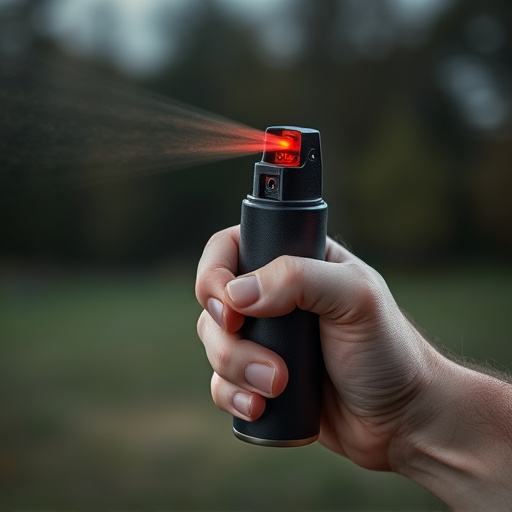Pepper spray is a powerful non-lethal tool for defending against dog attacks, using capsaicin to disrupt aggressive behavior. Civilian-grade pepper sprays come in various strengths, with oleoresin capsicum (OC) offering robust protection against large breeds. Storage should prioritize safety, and usage requires understanding local laws, aiming for the dog's face at a distance of 2-3 feet. Regular training enhances responsible use while avoiding unintended harm to people or pets.
In today’s world, being prepared for unexpected encounters is crucial. One effective self-defense tool gaining popularity among civilians is pepper spray, especially against aggressive dogs. This article explores the power of pepper spray as a defense mechanism, delving into its efficacy against dogs and providing insights on different types suitable for civilian use. We’ll guide you through safe handling practices, legal considerations, and practical tips to ensure responsible usage.
- Understanding Pepper Spray and Its Efficacy Against Dogs
- Types of Pepper Spray for Civilian Use
- Safe Handling and Application Techniques
- Legal Considerations and Best Practices
Understanding Pepper Spray and Its Efficacy Against Dogs
Pepper spray, a non-lethal self-defense tool, has gained popularity for its effectiveness in deterring potential threats. When it comes to protecting against dogs, pepper spray can be a game-changer. Dog attacks can be unpredictable and potentially dangerous, making a swift and powerful deterrent like pepper spray invaluable. The active ingredient in pepper spray, capsaicin, triggers the dog’s pain receptors, causing temporary blindness, coughing, and difficulty breathing. This disruption disrupts the dog’s aggressive behavior, allowing the user time to escape or defuse the situation.
The efficacy of pepper spray against dogs is well-documented. Studies show that when used correctly, it can stop even large and powerful breeds in their tracks. However, it’s crucial to use pepper spray as a last resort and understand its limitations. Dogs have varying sensitivity levels, and factors like breed, size, and training can influence how they respond. Therefore, while pepper spray is an effective deterrent, it should be accompanied by other safety measures and a thorough understanding of canine behavior.
Types of Pepper Spray for Civilian Use
Civilian-grade pepper spray offers a range of options for personal protection, including specific formulas designed to defend against dogs. When it comes to types, there are primarily two categories: oleoresin capsicum (OC) and capsaicin. OC pepper spray is known for its high concentration, providing a powerful defense against aggressive canines. It’s often the preferred choice for those seeking robust protection against dog attacks.
Capsaicin-based sprays, while still effective, tend to have lower concentrations, making them suitable for general personal safety purposes. These include self-defense scenarios involving humans and animals alike. The variety in strengths ensures civilians can choose based on their needs—whether it’s a light spray for unexpected encounters or a more intense formula specifically tailored to deterring dog aggression.
Safe Handling and Application Techniques
When handling civilian-grade pepper defense spray, safety should always be a top priority. It’s crucial to store the spray in a secure, out-of-reach location, especially if children or pets are present. Pepper spray is potent and can cause significant irritation; therefore, it should only be used as a last resort when facing an attack from a dog or other threat. Always ensure proper ventilation in the area where you store and use the spray.
Application techniques vary slightly depending on the type of pepper spray and the specific threat. When defending against dogs, aim for the face—eyes, nose, and mouth—as these areas will cause the most discomfort. Keep a safe distance, typically 2-3 feet, and use quick, short bursts. Avoid inhalation as much as possible, and be prepared to reapply if needed. Regular training can help individuals become more comfortable with using pepper spray effectively and responsibly against dogs or any other potential danger.
Legal Considerations and Best Practices
When considering a pepper spray defense against dogs, it’s crucial to understand the legal considerations in your region. While many areas permit the use of civilian-grade pepper spray for self-defense, including against aggressive canines, local laws and regulations can vary significantly. Always check with your local law enforcement or legal authorities to ensure compliance; some regions may require permits or have restrictions on where and how such devices can be carried.
Best practices dictate a measured and responsible approach when using pepper spray. Aim for the dog’s face, eyes, and nose, as these areas are most sensitive to capsaicin, the active ingredient in pepper spray. Keep a safe distance and allow several seconds after spraying for the effects to set in, giving the canine time to retreat or calm down. If the dog continues to pose a threat, repeat the spray application according to the product’s instructions. Never aim at people, especially children or pets, as off-target use can lead to unintended harm.
Pepper spray has established itself as a valuable tool for civilian self-defense, especially against dogs. By understanding its efficacy, selecting the right type for your needs, and mastering safe handling techniques, individuals can effectively deter canine aggressors. However, it’s crucial to stay informed about local laws and best practices to ensure responsible usage. Armed with knowledge and precautions, pepper spray defense against dogs can be a powerful strategy for personal safety in various scenarios.
